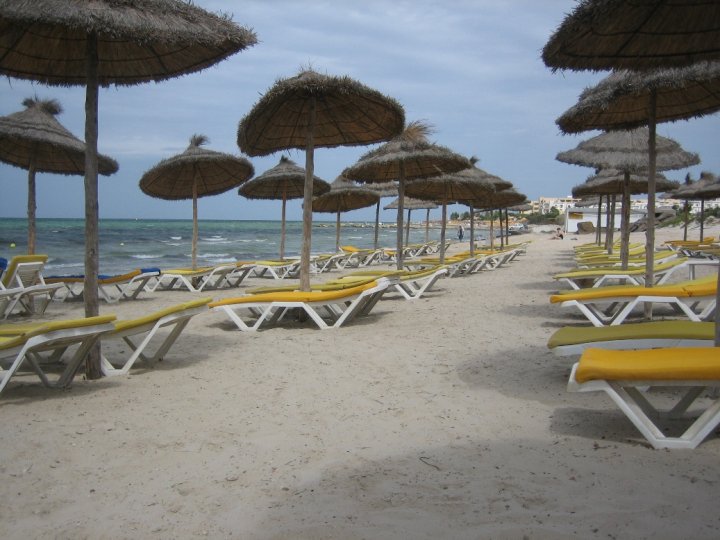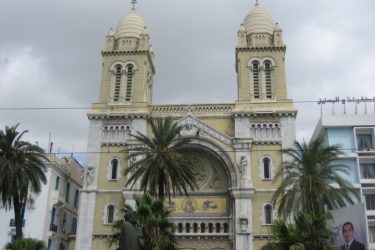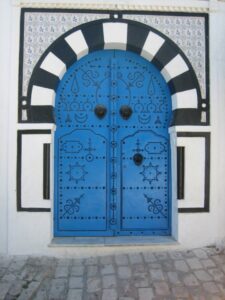Travelling to Tunisia provides an enthralling experience of a North African nation that skillfully combines a rich cultural tapestry, varied landscapes, and ancient history. Tunis, the capital, is a dynamic blend of contemporary avenues, ancient medinas, and archaeological monuments. A UNESCO World Heritage site, Tunis’s Medina entices with its winding lanes, humming souks, and the impressive Ez-Zitouna Mosque.
The ancient city-state of Carthage offers evidence of Tunisia’s illustrious past. The Carthage Museum and the Antonine Baths are two examples of the archaeological remains that offer insights into the once-powerful civilization.
With its blue and white architecture, the charming seaside hamlet of Sidi Bou Said provides expansive views of the Mediterranean. Tourists can browse the bougainvillea-draped tiny lanes and find unique artwork in the neighborhood galleries.
The huge dunes of the Grand Erg Oriental enthrall with their constantly shifting hues, displaying Tunisia’s various landscapes. A treasure on the UNESCO World Heritage List is the old city of Kairouan, with its Great Mosque and mediaeval medina.
The island of Djerba offers a tranquil getaway with its sandy beaches and interesting historical monuments like the El Ghriba Synagogue. With its unique blend of historic sites, energetic cities, and breath-taking scenery, Tunisia beckons visitors to set out on a trip spanning millennia and experience the graciousness of North African hospitality. In this article, we will give the best things to do and see in Tunisia when you visit.
Visit Tunis, Tunisia
The capital of Tunisia, Tunis, is a city that skillfully combines modernism, culture, and history. The UNESCO-listed Medina, a winding labyrinth of colorful souks, historic sites, and narrow lanes, is the city’s center. The vibrant marketplaces provide a sensory experience with their vibrant textiles, traditional crafts, and the fragrances of spices, while the Zitouna Mosque, which dates back to the eighth century, stands as an icon of Islamic architecture in Tunisia.
Housed in a former palace, the Bardo Museum offers a unique collection of Roman mosaics that shed light on Tunisia’s rich archaeological past. The avenue Habib Bourguiba, which bordered with trees and features stores, cafes, and French colonial architecture, is a colorful contrast to the old medina and represents the modern city.
In locations like the Café des Nattes in the Medina, where locals and visitors congregate for mint tea and conversation, Tunis embraces a blend of cultures. The fashionable La Marsa neighborhood, which is well-known for its beach cafes, art galleries, and lively ambiance, is a prime example of the city’s thriving arts sector.
The contrast between the ancient and the modern in Tunis tells a fascinating story about the country’s past and present, making it an enthralling destination for travelers looking for a fully complete North African experience.
Beach Resorts in Tunisia
Though its rich history and cultural attractions are what make Tunis the city famous, its Mediterranean coastline also boasts a number of beach resorts that offer the ideal combination of beachside charm and leisure.
Situated in the outskirts of Tunis, the Carthage Coast is home to opulent beach resorts with access to immaculate sandy beaches and expansive views of the sea. These resorts, which offer luxurious amenities, spa treatments, and mouth-watering food, offer a peaceful retreat from the busy city.
Known for its picturesque Mediterranean atmosphere, La Marsa is a seaside suburb with resorts on the beach that are popular with both residents and tourists. These chic resorts offer the ideal combination of coastal relaxation and urban exploration, thanks to their close proximity to the city’s cultural attractions and fashionable lodging.
Another seaside town close to Tunis, Gammarth, has a number of upscale beach resorts. Luxurious retreats with contemporary amenities and breath-taking views of the sea are drawn to Gammarth, which known for its upmarket atmosphere and picturesque coastline.
Travelers wishing to combine the best of both worlds in this alluring North African location will find that these beach resorts in Tunis cater to a wide range of interests, from soaking up the exciting city scene to unwinding on the sun-kissed Mediterranean shores.
Visit Amphitheatre of El Jem in Tunisia
Situated in the Tunisian village of El Djem, the Amphitheatre of El Jem is a breath-taking example of the magnificence of Roman engineering and construction. Constructed around the third century AD, this enormous amphitheater recognized as a UNESCO World Heritage site. It is among the best-preserved Roman amphitheaters worldwide.
The amphitheater, sometimes called the Colosseum of North Africa, held gladiatorial matches and other public performances and could hold up to 35,000 spectators. With its enormous walls and well-preserved basement chambers, the structure’s sheer size provides a vivid window into ancient Rome’s way of life.
El Jem is unique because of its exceptional preservation. The large elliptical arena and the complex system of underground corridors where animals and gladiators waited for their time in the arena fascinatingly reveal roman architecture.
Climbing the imposing walls of the Amphitheatre of El Jem allows visitors to take in expansive vistas of the surrounding landscape. A further cultural element added by the yearly International Festival of Symphonic Music, which takes place inside this historic stadium, converting this archaeological wonder into a space for contemporary artistic expression. El Jem is a magnificent reminder of Roman civilization’s ongoing influence and Tunisia’s rich historical past.
Visit Djerba in Tunisia
The charming island of Djerba is located off the southern coast of Tunisia. A location skillfully combines breath-taking coastal scenery, a laid-back vibe, and a rich history. Djerba, often called the “Island of Dreams,” inhabited for thousands of years, and its cultural mosaic clearly shows influences from the Phoenician, Roman, and Arab civilizations.
The main attraction on the island is Houmt Souk, a bustling village with a medina that features traditional markets, whitewashed buildings, and the Ghazi Mustapha Tower, which resembles an ancient fortification. One example of the island’s varied history is the Jewish Synagogue, El Ghriba, which is among the oldest synagogues in the world.
The coast of Djerba is home to immaculate beaches, Sidi Mahrez being especially well-known for its golden sands and glistening waves. Sun-seekers and lovers of water sports lured to these picturesque beaches.
The island is home to several unique attractions, such as the Djerba Explore Park, an amusement park featuring scenes from Star Wars that partially filmed on the island and reconstructions of traditional Djerbian buildings.
Warm weather, historical landmarks, and a thriving cultural scene combine to make Djerba an alluring destination for travelers looking for a unique and authentic Tunisian experience.
Visit Carthage in Tunisia
Located in Tunisia on the Gulf of Tunis, Carthage is a historic city with a rich millennium-long history. Carthage, which the Phoenicians founded in the ninth century BC, grew to be a strong maritime kingdom that rivalled Rome in the Mediterranean. Its UNESCO World Heritage listing and archaeological remnants attest to its historical significance now.
Visitors can take a wonderful trip back in time to discover the ruins of Carthage, which dispersed around a contemporary Tunisian suburb. The scale of grandeur seen in the Antonine Baths, which were once among the greatest bath complexes in the Roman Empire. The Punic Ports, historic harbors with the remains of ship sheds, give light on Carthage’s nautical might.
Thousands of people saw performances at the Roman Theatre, which previously positioned on a hill overlooking the sea. The famous Carthage Room mosaic is among the many artefacts kept in the Carthage National Museum.
Among the ruins of Carthage, the Tophet is noteworthy. A sacred burial site illuminates the Punic religious practices of the city. With the Acropolium at its summit, the Byrsa Hill provides sweeping views of the surroundings.
Carthage is a must-visit location for history buffs discovering North Africa’s rich legacy because of its layers of history and archaeological marvels, which serve as a witness to the development and fall of civilizations.
Explore the Tamerza Oasis in Tunisia
Tucked away in the parched terrain of southwest Tunisia, Tamerza Oasis is a mesmerizing location that highlights the tenacity of the natural world and the beauty of desert life. This oasis is a component of the wider Tozeur region, which is well-known for its rich cultural diversity, palm trees, and traditional architecture.
With its characteristic troglodyte homes carved into the rocky slopes, Tamerza stands out and provides a rare window into the traditional way of life in this oasis of the desert. These historic subterranean buildings demonstrate the ingenuity of the locals while acting as a natural barrier against the severe desert climate.
Rich date palm plantations beautify the oasis, offering a striking contrast to the parched surroundings. Wander through the palm groves’ shady lanes and marvel at the complex irrigation systems, or falaj, that allow life to survive in such a hostile environment.
The deserted settlement of Tamerza lends the oasis a sense of mystery and sorrow with its crumbling mud-brick buildings that tell a tale of a bygone era. The adjacent oases of Chebika and Mides, each with its own distinct charm and cultural insights, further enrich the exploration.
Travelers may connect with the enduring fascination of Tunisia’s desert landscapes by experiencing the harmony between nature and human innovation through an interactive exploration of Tamerza Oasis.
Visit Sidi Bou Said in Tunisia
The charming coastal town of Sidi Bou Said, located in northern Tunisia, is a vision of white and blue. With its cobblestone lanes, blue and white architecture, and breath-taking vistas of the Mediterranean Sea, it exudes charm. This charming hamlet, perched atop a hill, has long served as an inspiration to authors and painters.
Sidi Bou Said, distinguished by its recognizable blue doors, white-washed buildings embellished with vivid bougainvillaea, and elaborate wrought-iron railings, provides a classic aesthetic that carries tourists to a dreamlike Mediterranean setting. The streets lined with charming cafes, craft stores, and art galleries, making for a pleasant atmosphere for strolls.
The town is home to the exquisitely preserved 18th-century mansion that displays the traditional way of life and artisanship of Tunisians, the Museum Dar El-Annabi. The architecture is distinctly Andalusian, with winding alleys that lead to picturesque vistas and secret squares.
The Café des Nattes is a well-known destination for mint tea and expansive views of the Mediterranean in Sidi Bou Said. A must-see place on Tunisia’s Mediterranean coastline, Sidi Bou Said’s cliffside setting offers a picturesque setting for observing the fusion of history, culture, and natural beauty.
Festivals in Tunisia
With a diverse population and a wealth of cultural legacy, Tunisia has a number of festivals that honor its artistic, religious, and historical traditions. The Carthage International Festival, which takes place in the historic ruins of the ancient city, is one prominent event. Attracting both local and international performers, this cultural spectacle comprises performances in the arts, dance, theatre, and music.
Tunisia’s historic center comes to life during the Festival of the Medina, which features a lively display of traditional dance, music, and handcrafted goods. The celebrations overflow into the medina’s little lanes, making for a vibrant and engrossing atmosphere.
In Tunisia, people celebrate the two main Islamic holidays, Eid al-Fitr and Eid al-Adha, with considerable fervor. Families get together for holidays, prayer, and altruistic endeavors, which strengthens their bond and feeling of community.
A distinctive cultural event, the International Festival of the Sahara in Douz honors the customs of the desert with camel racing, traditional music, and crafts made by nomadic people. It offers an intriguing look at Tunisia’s history as a desert nation.
Among other things, these festivals highlight Tunisia’s rich cultural diversity and give guests an opportunity to interact with the lively customs of the nation, developing a closer bond with its citizens and their festivities.














